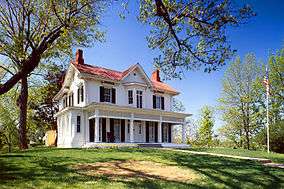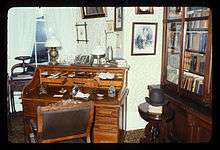Frederick Douglass National Historic Site
| Frederick Douglass National Historic Site | |
|---|---|
 | |
  | |
| Location | Washington, D.C., USA |
| Nearest city | Washington, D.C. |
| Coordinates | 38°51′48″N 76°59′07″W / 38.86333°N 76.98528°WCoordinates: 38°51′48″N 76°59′07″W / 38.86333°N 76.98528°W |
| Area | 9 acres (0.04 km2) |
| Established | February 12, 1988 |
| Visitors | 23,226 (in 2005) |
| Governing body | National Park Service |
| Website | Frederick Douglass National Historic Site |
The Frederick Douglass National Historic Site, administered by the National Park Service, is located at 1411 W St., SE in Anacostia, a neighborhood east of the Anacostia River in Southeast Washington, D.C.. Established in 1988 as a National Historic Site, the site preserves the home and estate of Frederick Douglass, one of the most prominent African Americans of the 19th century. Douglass lived in this house, which he named Cedar Hill, from 1877 until his death in 1895. Perched high on a hilltop, the site also offers a sweeping view of the U.S. Capitol and the Washington D.C. skyline.
History
The site of the Frederick Douglass home was originally purchased by John Van Hook circa 1855. Van Hook built the main portion of the present house soon after taking possession of the property. For a portion of 1877 the house was owned by the Freedom Savings and Trust Company. Later that year Douglass purchased the home and eventually expanded its 14 rooms to 21, including two-story library and kitchen wings. The house has an "L" shape and its plan is reminiscent of the design of Andrew Jackson Downing.[1]
With the election of President Rutherford B. Hayes in 1876, Douglass hoped for a political appointment, likely postmaster for Rochester, New York or ambassador to Haiti. Instead, he was appointed marshal for the District of Columbia, a role which he accepted.[2] His appointment to this highly visible position marked the first time a black man successfully received a federal appointment requiring Senate approval.[3] Douglass, however, was not asked to fill many of the roles expected of a marshal. Typically, the marshal would attend formal White House gatherings and directly introduce guests to the President. Douglass, excused from this role, later complained that he should have resigned because of the slight.[4] Still, the job brought him financial stability and, in 1878, he purchased the 20-room Victorian home on nine acres which they named Cedar Hill. He bought an additional 15 acres around the property the next year.[5]
In the home, Douglass became a cultivated member of high society. He and his grandson Joseph played the music of Franz Schubert in the west parlor which served as music room.[6] Here he also worked on what would be his last autobiographical book, Life and Times of Frederick Douglass, first published in 1881 and reissued ten years later.[2] His wife Anna had a stroke in 1882 which left her partially paralyzed; she died on August 4 and Douglass became depressed.[7] "The main pillar of my house has fallen", he wrote to a friend.[8]
In January 1884, Douglass applied for a marriage license at District of Columbia City Hall before heading to the home of Reverend Francis James Grimké and Charlotte Forten Grimké, where he married a white woman named Helen Pitts.[9] The marriage, held January 2,[10] was not approved by most members of either family. Helen's father, an abolitionist who was previously proud to know Douglass personally, never offered his blessing and refused to visit Washington unless he knew his daughter and her husband were out of town.[11] Douglass had hired Pitts as a clerk in 1882. She was a graduate of Mount Holyoke College and had been a teacher of freed blacks in Virginia and Indiana.[10] Interviewed about her marriage, she responded, "Love came to me and I was not afraid to marry the man I loved because of his color."[9] One newspaper article noted, "Goodbye, black blood in that family. We have no further use for him. His picture hangs in our parlor, we will hang it in the stables."[11]

On February 20, 1895, Douglass attended a women's rights rally in Washington and was escorted to the platform by Anna Howard Shaw and Susan B. Anthony. He returned to Cedar Hill for an early supper and intended to attend a neighborhood black church. As he was telling his second wife Helen about one of the day's speakers, he suddenly collapsed.[12]
Later history
After Douglass's death, his widow, Helen Pitts Douglass, founded the Frederick Douglass Memorial and Historical Association in 1900. In 1916, the National Association of Colored Women's Clubs joined with the association. These groups owned the house until 1962, when the federal government took the deed to the house through the National Park Service, with the intent of restoring and preserving it.[13]
Also on site are an interpretive visitor center and a reconstruction[14] of Douglass's "Growlery", a small stone building in which he secluded himself while writing and studying.
The Frederick Douglass National Historic Site is located about a ten-minute walk from the Anacostia Metro station, though walking from the station is often discouraged by National Mall information workers and tourist guide books, who recommend taking a taxi due to high crime in Southeast D.C.
In 2017, the Frederick Douglass National Historical Site is scheduled to be depicted on the thirty-seventh quarter in the America the Beautiful Quarters series.
See also
References
- ↑ Kaiser, p. 438.
- 1 2 Oakes, James. The Radical and the Republican: Frederick Douglass, Abraham Lincoln, and the Triumph of Antislavery Politics. New York: W. W. Norton and Company, 2007: 276. ISBN 978-0-393-33065-6
- ↑ Stauffer, John. Giants: The Parallel Lives of Frederick Douglass and Abraham Lincoln. New York: Twelve/Hachette Book Group, 2008. ISBN 978-0-446-54300-2
- ↑ McFeely, William S. Frederick Douglass. New York: W. W. Norton and Company, 1991: 291. ISBN 0-393-31376-X
- ↑ O'Keefe, Rose. Frederick & Anna Douglass in Rochester, New York: Their Home Was Open to All. Charleston, SC: The History Press, 2013: 90. ISBN 978-1-62619-181-5
- ↑ McFeely, William S. Frederick Douglass. New York: W. W. Norton and Company, 1991: 306. ISBN 0-393-31376-X
- ↑ Burchard, Peter. Frederick Douglass: For the Great Family of Man. New York: Simon & Schuster, 2003: 190. ISBN 0-689-83240-0
- ↑ Barnes, L. Diane. Frederick Douglass: Reformer and Statesmen. New York: Routledge, 2013: 123. ISBN 978-0-415-89111-0
- 1 2 O'Keefe, Rose. Frederick & Anna Douglass in Rochester, New York: Their Home Was Open to All. Charleston, SC: The History Press, 2013: 94. ISBN 978-1-62619-181-5
- 1 2 Barnes, L. Diane. Frederick Douglass: Reformer and Statesmen. New York: Routledge, 2013: 124. ISBN 978-0-415-89111-0
- 1 2 McFeely, William S. Frederick Douglass. New York: W. W. Norton and Company, 1991: 320. ISBN 0-393-31376-X
- ↑ McFeely, William S. Frederick Douglass. New York: W. W. Norton and Company, 1991: 381. ISBN 0-393-31376-X
- ↑ "Frederick Douglass House". Historic American Buildings Survey. Library of Congress.
- ↑ National Park Service website on Cedar Hill; one of the rotating "Did You Know?" text's begins, 'Behind Cedar Hill is a reconstruction of the "Growlery," where Frederick Douglass....'
- Kaiser, Harvey H. (2008). The National Park Architecture Sourcebook. Princeton Architectural Press; pp. 437–439. ISBN 1-56898-742-0
External links
| Wikimedia Commons has media related to Frederick Douglass National Historic Site. |
- Frederick Douglass National Historic Site official web site
- Frederick Douglass.org
- "Writings of Frederick Douglass", broadcast from the Frederick Douglass National Historic Site from C-SPAN's American Writers